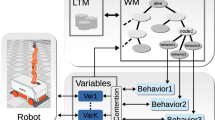Abstract
In this paper we present a behaviour-based mobile robot system for task execution. The behaviour model of this system consists of a number of motion behaviours, including reflexes and voluntary motion behaviours, and knowledge acquisition modules providing supporting information. Execution of a task is regarded as a problem-solving process. A blackboard model is introduced to overcome some shortcomings of the behaviour-based architectures, especially concerning modularity and task execution capability. The concept of attention is introduced in the behaviour control, which is more advantageous than the behaviour control mechanisms presented in the literature. Its introduction results in situation-dependent behaviour coordination. For efficient task execution, environment knowledge is maintained in a memory. Task-achieving behaviour is designed to make use of the memory when available.
Similar content being viewed by others
References
Arkin, R. C. (1989) Motor schema-based mobile robot navigation, International Journal of Robotics Research, 8 (4), 92–112.
Berger, M. O., Kubitz, O. and Weigt, T. S. (1995) Intra- and inter- robot communication, in Proceedings International Symposium on Intelligent Robotic Systems, Pisa, Italy pp. 105–112.
Borenstein, J. and Koren, Y. (1990) Real-time obstacle avoidance for fast mobile robots in cluttered environments, in Proceedings IEEE International Conference on Robotics and Automation, Ohio, pp. 572–577.
Borenstein, J. and Koren, Y. (1991) The vector field histogram - fast obstacle avoidance for mobile robots. IEEE Transactions on Robotics and Automation, 7(3), 278–288.
Brooks, R. A. (1986) A robust layered control system for a mobile robot. tIEEE Journal of Robotics and Automation, RA-2(1), 14–23.
Brooks, R. A. (1989) A robot that walks; emergent behaviours from a carefully evolved network, in Proceedings IEEE International Conference on Robotics and Automation, Scottsdale, USA, pp. 692–696.
Brooks, R. A. (1991)New approaches to robotics. Science, 253, 1227–1232.
Deutsch, S. and Deutsch, A. (1993) Understanding the Nervous System, IEEE Press, Piscataway, NJ.
Elfes, A. (1989) Using occupancy grids for mobile robot perception and navigation. IEEE Computer, 46–57.
Ghez, C. (1991) The control of movement, in Principles of Neural Science, Keudel E. R., Schwartz J. H. and Jessell T. M. (eds), Prentice-Hall International, London, pp. 533–547.
Hartley, R. and Pipitone, F. (1991) Experiments with the sub- sumption architecture, in Proceedings IEEE International Conference on Robotics and Automation, Sacramento, CA, pp. 1652–1658.
Khatib, O. (1986) Real-time obstacle avoidance for robot ma- nipulator and mobile robots. International Journal of Robotics Research, 5(1), 90–98.
Liscano, R., Manz, A., Stuck, E. R., Fayek, R. E. and Tigli, J. Y. (1995) Using a blackboard to integrate multiple activities and achieve strategic reasoning for mobile-robot navigation. IEEE Expert, 24–35.
Merriam-Webster (1990) Webster's Ninth New Collegiate Dictio- nary, Merriam-Webster Inc., Publishers, Massachusetts.
Moravec, H. P. and Elfes, A. (1985) High resolution maps from wide angle sonar, in Proceedings IEEE International Conference on Robotics and Automation, Missouri, pp. 116–121.
Nisenfeld, A. E., David, J. R. and Boullart, L. (1989) Artificial Intelligence Handbook, Instrument Society of America Re- search.
Payton, D. W. (1986) An architecture for reflexive autonomous vehicle control, in Proceedings IEEE International Conference on Robotics and Automation, San Francisco, CA, pp. 1838–1845.
Peremans, H. and Van Campenhout, J. (1993) Triaural perception on a mobile robot, IEEE Transactions on Robotics and Automation, 9(1), pp. 36–48.
Saffiotti, A., Ruspini, E. H. and Konolige, K. (1993) Blending reactivity and goal-directedness in a fuzzy controller, in Proceedings 2nd IEEE Conference on Fuzzy Systems, San Francisco, CA, pp. 134–139.
Saunders, W. B. Company (1974) Dorland's Illustrated Medical Dictionary, 25th edn, Press of W. B. Saunders Company, Philadelphia.
Schmidt, R. A. (1988) Motor Control and Learning: a Behavioral Emphasis, Human Kinetics Publishers, Champaign, Illinois.
Shepherd, G. M. (1988) Neurobiology, Oxford University Press, Oxford.
Steels, L. (1994a) Building agents out of autonomous behaviour systems, in The ‘Artificial Life’ Route to ‘Artificial Intelligence’, Steels, L. and Brooks, R. (eds), Laurence Erlbaum, New Haven, CT.
Steels, L. (1994b) A case study in the behaviour-oriented design of autonomous agents, in Proceedings 1994 Conference on Simulation of Adaptive Behavior, Brighton, UK.
Van Brussel, H. (1995) Navigation issues in intelligent autonomous systems, in Proceedings International Conference on Intelligent Autonomous Systems, Karlsruhe, Germany, pp. 42–52.
Van Brussel, H., Vandorpe, J. and Huang, G. J. (1993) An inte- grated control system for enhanced autonomous navigation of mobile robots, in Proceedings Second International Con- ference on Mechatronics and Robotics, Duisburg, Germany, pp. 297–318.
Velthuijsen, H. (1992). The nature and applicability of the blackboard architecture, PhD Dissertation, University of Limburg, Maastricht.
Watanabe, M., Onoguchi, K., Kweon, I. and Kuno (1992) Architecture of behaviour-based mobile robot in dynamic environments, in Proceedings IEEE International Conference on Robotics and Automation, Nice, France, pp. 2711–2718.
Xu, H. (1997) Simulation and control of a service robot opera- tion, internal report, PMA division, Katholieke Universiteit Leuven, 97R07.
Xu, H. and Van Brussel, H. (1995) Neural avoidance behaviour of the mobile robot LiAS, in Proceedings 8th International Conference on Neural Networks and their Applications, Marseille, France, pp. 55–60.
Author information
Authors and Affiliations
Rights and permissions
About this article
Cite this article
Xu, H., Brussel, H.V. A behaviour-based architecture with attention control. Journal of Intelligent Manufacturing 9, 97–106 (1998). https://doi.org/10.1023/A:1008803610143
Issue Date:
DOI: https://doi.org/10.1023/A:1008803610143




